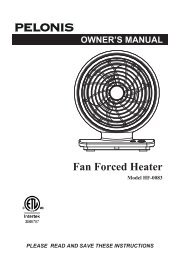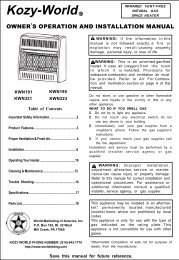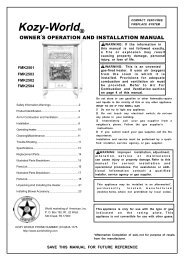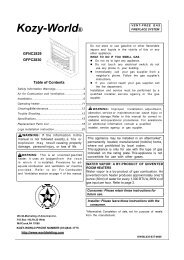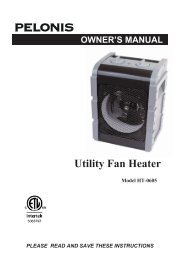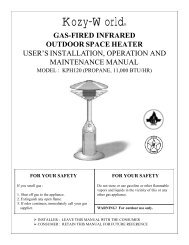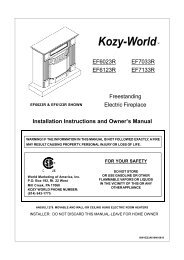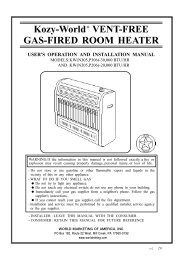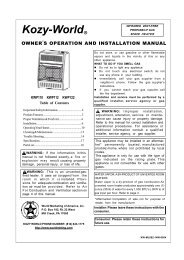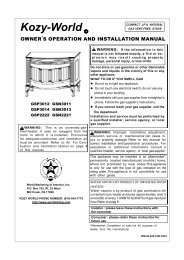owners manual for this appliance. - World Marketing of America, Inc.
owners manual for this appliance. - World Marketing of America, Inc.
owners manual for this appliance. - World Marketing of America, Inc.
You also want an ePaper? Increase the reach of your titles
YUMPU automatically turns print PDFs into web optimized ePapers that Google loves.
PORTABLEKEROSENE-HEATER“OWNER’S MANUAL”Kero-<strong>World</strong> ®MODEL : KW-12Be<strong>for</strong>e the first use <strong>of</strong> <strong>this</strong> heater, please read <strong>this</strong> OWNER'S MANUAL verycarefully. This OWNER'S MANUAL has been designed to instruct you as to theproper manner in which to assemble the heater, maintain the heater, store theheater, and most importantly, how to operate the heater in a safe and efficientmanner, please keep <strong>this</strong> <strong>manual</strong> <strong>for</strong> future reference.<strong>World</strong> <strong>Marketing</strong> <strong>of</strong> <strong>America</strong>, <strong>Inc</strong>.12256 William Penn HwyMill Creek, PA 170601- 800 - 776 - 9425 (9AM - 4PM EST)MON.- FRI. ONLYwww.yourheater.com4221-0048-0105/08 Rev. 05 Printed in South Korea
NEVER LEAVE THE HEATERUNATTENDED WHILE BURNING!WARNING!! RISK OF EXPLOSION / RISK OF FIRE! NEVER use any fuel other than water-clear 1-Kkerosene.! NEVER use fuel such as gasoline, benzene, paintthinners or other oil compounds in <strong>this</strong> heater.! NEVER refill heater fuel tank when heater is operatingor still hot.! NEVER use heater in areas where flammable vaporsor gases may be present.! NEVER fill heater fuel tank in living space; filltank outdoors.! NEVER store or transport kerosene in other than ametal or plastic container that is (1)acceptable<strong>for</strong> kerosene, (2) non-red in color, and (3) clearlymarked “Kerosene”. NEVER store kerosene inthe living space; kerosene should be stored in awell ventilated place outside the living area.! The unit is EXTREMELY HOT while in operation.Due to high surface temperatures, keepchildren, clothing, furniture, and othercombustible objects at least 36” away from topand front area.! RISK OF IN DOOR AIR POLLUTIONUSE HEATER ONLY IN WELL VENTILATEDAREAS. People with breathing problems should consulta physician be<strong>for</strong>e using the heater. In a house <strong>of</strong> typicalconstruction, that is, one that is not <strong>of</strong> unusually tightconstruction due to heavy insulation and tight seals againstair infiltration, an adequate supply <strong>of</strong> air <strong>for</strong> combustion andventilation is provided through infiltration; however, if theheater is used in a small room where less than 200 cubicfeet (5.7 m <strong>of</strong> air space is provided <strong>for</strong> each 1,000 BTU perhour <strong>of</strong> heater rating (considering the maximum burneradjustment), the door(s) to adjacent room(s) should be keptopen or the window to the outside should be opened atleast 1 inch (25.4 mm) to guard against potential buildup <strong>of</strong>indoor air pollution. DO NOT use the heater in a bathroomor any other small room with the door closed.! NEVER use heater to heat or boil water or use as acooking <strong>appliance</strong>.WARNING!!FAILURE TO INSTALL, MAINTAIN, AND/OROPERATE THIS KEROSENE HEATER ACCORDINGCAUTIONS- SAFETY GUIDE -TO MANUFACTURER’S INSTRUCTIONS MAYRESULT IN CONDITIONS WHICH CAN PRODUCEBODILY INJURY AND/OR PROPERTY DAMAGE.NOTE: The WARNING and IMPORTANT instructionsappearing in <strong>this</strong> <strong>manual</strong> are not meant to cover allpossible conditions and situations that may occur. Itmust be understood that common sense, caution, andcarefulness are factors which cannot be built into <strong>this</strong>heater. These factors must be supplied by the person(s)installing, maintaining, or operating the kerosene heater.Always contact your dealer, distributor, serviceagent, or the manufacturer on any problems orconditions you do not understand.! NEVER leave heater operating if you intend to leave <strong>for</strong>any period <strong>of</strong> time. Always make sure to turn heater <strong>of</strong>fand inspect to insure that it is completely extinguishedprior to going to bed.! NEVER leave heater unattended.! NEVER use as a source <strong>of</strong> heat <strong>for</strong> drying objects.! NEVER place objects on the top plate.WARNING!! RISK OF BURNS! NEVER operate the heater without the guard orgrille completely attlached.IF POOR QUALITY KEROSENE is used a rapidaccumulation <strong>of</strong> carbon and tar is likely. This may causea strong odor and will destroy the wick. Additionalheater damage may occur as the wick becomes moredifficult to adjust. The use <strong>of</strong> poor quality fuel could alsomake the wick very hard to extinguish. Always makesure the fire is out. (See page 12, Extinguishing theHeater.)ADJUSTMENT OF ROOM TEMPERATURE can not bechanged by adjusting the heater. A Kerosene heater iseither on or <strong>of</strong>f. There is no temperature adjustment. Ifheater output is reduced by lowering the wick in anyway, improper combustion will occur producing odorsand an accumulation <strong>of</strong> tar and carbon. If your roombecomes too hot, open a door or a window or turn <strong>of</strong>f theheater.SAVE THESE INSTRUCTIONS FORFUTURE REFERENCE!!1
NEVER LEAVE THE HEATERUNATTENDED WHILE BURNING!CONTENTS OF OWNER'S MANUALITEMPAGEITEMPAGECAUTIONS-SAFETY GUIDE INTRODUCTION FEATURES UNPACKING AND ASSEMBLY KEROSENE (1-K ONLY) FUELING YOUR HEATER AUTOMATIC IGNITION SYSTEM CHECKING THE IGNITION SYSTEM ADJUSTING THE WICK WICK MAINTENANCE1223456678 CARBON REMOVAL / DRY BURNING WICK ASSEMBLY WICK REPLACEMENT EXTINGUISHING THE HEATER AUTOMATIC SAFETY SHUT-OFF DEVICE LONG TERM STORAGE OF YOUR HEATER TROUBLE SHOOTING GUIDE PARTS LIST EXPLODED PARTS DRAWING SPECIFICATIONS89912121314151515 INTRODUCTIONPlease read <strong>this</strong> OWNER'S MANUAL carefully. It will show you how to assemble, maintain, and operatethe heater safely and efficiently to obtain full benefit from its many built-in features. FEATURESCarrying HandleFront Guard GrilleFuel GaugeFuel capTop Guard GrillRear Guard GrillBattery Case CoverManual Shut-<strong>of</strong>f KnobWick Adjuster KnobIgnition LeverIntergral Fuel TankDrip TrayFig. 12
NEVER LEAVE THE HEATERUNATTENDED WHILE BURNING!B) INSTALLING BATTERIES (Fig 6)Battery holder is located on the back <strong>of</strong> the heater.Open the battery cover from the battery holder.Insert two “c” cell batteries according to the plus(+) andminus(-) markings inside <strong>of</strong> the holder.Replace the battery cover to the heater.C) Now your heater is completely ready to use.Fig. 6Battery CoverBattery KEROSENE (1-K ONLY)It is EXTREMELY IMPORTANT to the operation <strong>of</strong> <strong>this</strong> heater that you use the proper grade <strong>of</strong> kerosene.The proper grade <strong>of</strong> kerosene is identified as 1-K Kerosene. DO NOT OPERATE THIS HEATER WITH ANYFUEL OTHER THAN 1-K KEROSENE! 1-K Kerosene has been refined to virtually eliminate contaminantssuch as sulphur, which can cause a rotten egg odor during operation <strong>of</strong> the heater.KEROSENE SHOULD ONLY BE STORED IN A BLUE CONTAINER THAT IS CLEARLY MARKED"KEROSENE". NEVER STORE KEROSENE IN A RED CONTAINER. Red containers are associated with gasoline.NEVER store kerosene in the living space. Kerosene should be stored in a well ventilated place outside theliving area.NEVER use any fuel other than water-clear 1-K kerosene.NEVER use fuel such as gasoline, benzene, alcohol, white gas, camp stove fuel, paint thinners, or other oilcompounds in <strong>this</strong> heater. These are volatile fuels that can cause explosion or uncontrolled flames.The best way to purchase kerosene is in a pre-packaged, metal or plastic, blue colored container.The second choice would be to buy it from a dealer who stores it in a 55 gallon drum. The third choice is tobuy kerosene from a dealer who stores it in a large underground (or above ground) tank. Kerosene that iscontaminated with even a small amount <strong>of</strong> water will prevent a kerosene heater from functioning properly. Asyou move from the first choice in purchasing kerosene (pre-packaged container) to the third choice (largestorage tank), the likelihood <strong>of</strong> water being present from condensation increases.If you purchase kerosene in bulk, know your dealer.It is normal <strong>for</strong> a kerosene heater to give <strong>of</strong>f a slight odor upon start-up and shut-down.After 5-10 minutes <strong>of</strong> operation, the heater should have reached its normal operating temperature and anyodor should be very slight.NEVER store kerosene in direct sunlight or near a source <strong>of</strong> heat.NEVER use kerosene that has been stored from one season to the next.Kerosene deteriorates over time. "OLD KEROSENE" WILL NOT BURN PROPERLY INTHIS HEATER.A variety <strong>of</strong> problems can result from using poor quality kerosene --- smoke, odor, low flame, difficult ignition,difficult shut-down, flame flickers and dies, excessive burning down <strong>of</strong> the wick, reduced wick life, wickadjuster sticking, excessive deposits on the wick, etc.. If you encounter any <strong>of</strong> the problems listed above,check your kerosene. If you discover that the kerosene is the problem, get a fresh supply <strong>of</strong> WATER-CLEAR1-K KEROSENE be<strong>for</strong>e using your heater again.4
NEVER LEAVE THE HEATERUNATTENDED WHILE BURNING! FUELING YOUR HEATERNEVER FILL THE HEATER FUEL TANK IN THE LIVING SPACE:FILL THE TANK OUTDOORS.Be<strong>for</strong>e fueling the heater, take the heater, the kerosene, and the <strong>manual</strong>siphon pump outdoors. To use the <strong>manual</strong> siphon pump, tighten the capon the top <strong>of</strong> the siphon, place the straight tube into the kerosenecontainer, and insert the flexible tube into the opening <strong>of</strong> the fuel tank. Bysqueezing the bulb <strong>of</strong> the siphon pump, fuel will be transferred from thekerosene container into the heater tank. (Fig. 7) Carefully watch the fuelgauge beside <strong>of</strong> the opening <strong>of</strong> the fuel tank so that you will know whenthe tank is getting full. When you approach the full mark, loosen the capon top <strong>of</strong> the siphon pump. This will stop the flow <strong>of</strong> kerosene. DO NOTOVERFILL YOUR HEATER. Allow the siphon pump to drain thoroughlybe<strong>for</strong>e you remove it from the tank and the kerosene container.Fig. 7After fueling the fuel tank <strong>of</strong> the heater by using siphon pump, make surethat you loosen (counter clock wise) the cap on the siphon pump to drainthroughly the remaining kerosene in the siphon pump. For the reuse <strong>of</strong>siphon pump, make sure that youtighten (clock wise) the cap on the siphon pump to transfer the keroseneinto the fuel tank properly. (Fig.8)LoosenTightenIMPORTANT NOTICE REGARDING FUELING OF THE HEATER :When fueling your heater <strong>for</strong> the firsttime and any other time when the tank has been completely empty, as in"Dry Burning" (page 8) make sureto allow the wick to soak a minimum 60 minutes be<strong>for</strong>e you attemptto light the heater. (Take note <strong>of</strong> thetime you started to soak the wick or use a kitchen timer or wristwatch with an alarm feature) Failure toproperly soak the wick can trap air pockets in the wick causing the heaterto burn poorly.Premature ignition can destory your wick.IMPORTANT NOTICE REGARDING FIRST IGNITION OF HEATERThe first time you light your heater there may be some odor due to theburning <strong>of</strong>f <strong>of</strong> oils used in themanufacturing process. To avoid <strong>this</strong> you may wish to burn the heateroutside on a calm and windless day.If it s windy consider a porch or garage or other room where thewindows can be open to disperse the odor.Fig. 85
NEVER LEAVE THE HEATERUNATTENDED WHILE BURNING!WICKFlLAMENT1~2mmIGNITERFig. 13 Fig. 14 Fig. 15To replace the igniter plug (Fig. 16);–Remove the batteries.–Remove the 2 Guard Bracket by removing 4 Screws and lift <strong>of</strong>f theGuard grill assembly.–Remove burner chamber and push the ignition lever to raise theigniter plug.–Pull the igniter plug in and turn in a clockwise direction to remove.–Install a new igniter plug (Type "B", 2.5V DC, 1A only) by pushing itin and turning it in a counter-clockwise direction.–Reassemble the heater and replace the batteries.–TEST IGNITIONFig. 16Using the wick adjuster knob, raise the wick to its maximum height.Push the ignition lever.The igniter plug should be within 1~2mm <strong>of</strong> the wick when the ignition lever is fully engaged. (Fig. 13) ADJUSTING THE WICKAfter lighting the heater, it is important to check the heater flame within the first 5-7 minutes <strong>of</strong> operation.During the first 5 minutes after ignition, the burner chamber warms up and flames will become visible at the top<strong>of</strong> burner. These flames will gradually build up. After 5-7 minutes <strong>of</strong> operation, you should use the wickadjuster knob to obtain the proper flame height. The proper flame height is a 1/2” flame above the center flamespreader disk, with even distribution <strong>of</strong> flame around the flame spreader disk visible through the glass cylinder<strong>of</strong> the heater. See pictures below <strong>for</strong> reference.As you continue to operate the heater, the temperature <strong>of</strong> the heater and the temperature <strong>of</strong> the room willcontinue to change. As the heater warms up, the kerosene in the tank will vaporize faster, and <strong>this</strong> couldrequire adjusting the wick adjuster down in order to maintain the desired 1/2" flame height. There<strong>for</strong>e, it isnecessary to continue to monitor the flame height, and to make adjustments using the wick adjuster knob tokeep the proper flame height. It is recommended that the heater be checked every 30 minutes in order to keepthe proper adjustment because periodic adjustment Fig.16 is required.CORRECT FLAMEProper combustionFLAME TOO HIGHCan Produce smokeand sootIMPORTANT NOTE : NEVER LEAVE THE HEATER UNATTENDED WHILE BURNING.Always make sure to turn the heater <strong>of</strong>f and inspect it to insure that it is completelyextinguished prior to going to bed.7FLAME TOO LOWCan produce odorand carbon monoxide
NEVER LEAVE THE HEATERUNATTENDED WHILE BURNING!NOTE : During start-up, small adjustments to the flame can be per<strong>for</strong>med by usingthe burner knob on the front <strong>of</strong> the burner and MOVING THE BURNER FROMSIDE TO SIDE until the flame at the top <strong>of</strong> burner is as even as possible.DO NOT TOUCH THE BURNER KNOB ONCE THE HEATER HAS REACHEDNORMAL OPERATING TEMPERATURE AND THE FLAME HAS STABILIZED.THE BURNER KNOB IS VERY HOT DURING OPERATION.IMPORTANT NOTE : This heater is designed to operate with a flameheight <strong>of</strong> a 1/2” above the flame spreader disk at the top <strong>of</strong> the burner. Forproper combustion to occur, it is very important that the flame height beFig. 17adjusted so that it is neither too high, nor too low. Operating the heater at a wick setting below the minimumrecommended setting (the wick-stop setting) could result in the risk <strong>of</strong> fire and / or carbon monoxide poisoning.NOTE : If you find that the wick will not raise, push the safety reset lever (see diagram on P.2) to engage thesafety shut-<strong>of</strong>f device. Then dial the wick up via the wick adjuster knob.WARNING : RISK OF INDOOR AIR POLLUTION AND FIRE, DO NOT OPERATE HEATER AT WICKSETTING LOWER THAN MINIMUM WICK-STOP SETTING. WICK MAINTENANCE / DRY BURNWick maintenance is necessary to prevent soot production, low heat output and per<strong>for</strong>mance issues. Carbon and tarwill build up on the top <strong>of</strong> the wick during regular use <strong>of</strong> <strong>this</strong> product. Wick maintenance is required within the firstseven (7) days <strong>of</strong> your first use <strong>of</strong> the heater and every 2 tankfuls <strong>of</strong> fuel and/or every week during the heatingseason. If the wick feels hard and brittle, <strong>this</strong> indicates that wick maintenance is necessary in order to keep yourheater per<strong>for</strong>ming accordingly.Check Your Wick Often!If the wick is hard to light.If the wick is hard to raise or difficult to adjust by turning the wick adjustment knob.If the wick fails to drop completely when you press the shut-<strong>of</strong>f knob.If the top <strong>of</strong> the wick is stiff and hard.Note: Poor fuel or fuel contaminated with water will also turn the wick hard. PERFORMING WICK DRY BURN / REMOVING CARBON FROM THE WICK"Dry burning" your heater will cause a strong odor. For <strong>this</strong> reason it is best to "dry burn" your heater outdoors on a day that iscompletely calm and windless. If it s too windy outside you can consider a porch, breezeway or other room with all <strong>of</strong> the windowsopen to disperse the strong odor.Step 1With your fuel tank nearly empty, burn your heater (without refilling) until the flame starts to burn out thenraise the wick to its highest possible setting and leave it there until it burns out completely. Wait 60 minutes,then re-light the wick (with a match if necessary) and allow it to burn out again. Once the heater is cool to thetouch, remove the cabinet and brush the top <strong>of</strong> the wick with an old tooth brush or other stiff bristle brush toremove any remaining ash. A canister type vacuum cleaner may be a useful tool in removing <strong>this</strong> ash.Step 2 The first step should remove most carbon and your wick should feel s<strong>of</strong>ter to the touch. If any part still feelshard, you can use small pliers to pinch these hard spots and break up the carbon into pieces. After doing<strong>this</strong>, replace the cabinet, add a small amount <strong>of</strong> fuel, wait at least one hour and then repeat step 1.Carry out Carbon Removal / Dry Burning within (7) seven days after your first use <strong>of</strong> your new heater to reducecarbon build-up on the wick’s burning surface, after every two tankfuls <strong>of</strong> fuel and/or every week during the heatingseason. Afterwards, dry burn your heater anytime the wick appears to be hard. CHECK YOUR WICK OFTEN! Dryburn your wick and remove all fuel from your heater at the end <strong>of</strong> the heating season.Note: Burn your heater dry, as noted above, weekly during the heating season or necessarythereafter. Check your wick <strong>of</strong>ten to see if CARBON REMOVAL / DRY BURNING isnecessary. Carbon removal will NOT be effective if your fuel has been contaminated bywater or any other liquid. In <strong>this</strong> case you must clean the fuel tank, replace the wickand soak it <strong>for</strong> 60 MINUTES in fresh, K-1 Kerosene.8
NEVER LEAVE THE HEATERUNATTENDED WHILE BURNING! WICK ASSEMBLY- Check at least once a month!!The burner assembly sits on top <strong>of</strong> the wick guide. Over time, tar deposits canaccumulate on the wick guide, and <strong>this</strong> can prevent the burner assemby fromseating properly. This can result in poor combustion, smoke, odor, etc.. To prevent<strong>this</strong> from happening, tar deposits on the wick guide can be removed as follows:–Making sure that the heater is both cool and turned <strong>of</strong>f, lower the wick to the "<strong>of</strong>f" position.–Remove the batteries (located at the rear <strong>of</strong> the heater).–Remove the 2 guard bracket by removing 4 screws and lift <strong>of</strong>f the grill assemblyas shown in illustration. (Fig. A)–Remove burner charnber.–Using the wick adjuster knob, raise the top <strong>of</strong> the wick until it is even with the top<strong>of</strong> the wick guide. Using a flat-edge screwdriver, scrape <strong>of</strong>f the tar deposits.Be careful not to allow any <strong>of</strong> the tar deposits to drop into the grooves <strong>of</strong> the wickguide. A small vacuum cleaner can be used to remove the tar deposits that havebeen scraped <strong>of</strong>f (Fig.B).–Reassemble the heater and replace the batteries. WICK REPLACEMENTFig.AFig.BThe wick in your heater needs replacing if, after repeated cleanings, any <strong>of</strong> the following conditions still exist: slow to light,hard movement <strong>of</strong> the wick adjuster knob, kerosene odor while burning, low heat output, slow warm up, damaged wick.Use only a genuine replacement wick.REPLACEMENT WICK NUMBER : Dura Heat : DH-249, Pick-A-Wick : PW-79, Kero <strong>World</strong> : 20430If cleaning the Wick does not improve per<strong>for</strong>mance, you will need to replace the Wick Refer to the "TROUBLESHOOTING GUIDE", see page 14. which outlines conditions under which the Wick should be replaced.CAUTION : Use ONLY a genuine Replacement Wick. DO NOT attempt to substitute any other type <strong>of</strong> Wick deviceor a Wick designed <strong>for</strong> another brand or model heater You could damage the heater and create a potential firehazard.Call customer service at 1-800-776-9425, to order wick.ATTENTION : The only tools needed to replace the Wick are :A Pair <strong>of</strong> Pliers A Cross Screwdriver A Plastic Bag with a Twist Tie1. Push down the <strong>manual</strong> shut-<strong>of</strong>fKnob and turn the WickAdjustment KnobCOUNTERCLOCKWISE in thedirection <strong>of</strong> "OFF".2. Use screwdriver to loosen andremove 3 screws that fix cabinetbase to fuel tank. Remove theWick-Adjuster Knob and IgnitionKnob.3. Tilt slightly and lift up the Cabinet& Grill assembly using both handsand lift away from the heater.9
NEVER LEAVE THE HEATERUNATTENDED WHILE BURNING! EXTINGUISHING THE HEATERTo extinguish the heater, push down on the <strong>manual</strong> shut-<strong>of</strong>f knob(Fig.18)with one hand while holding the wick adjuster knob in the other hand. Youwill feel the pressure <strong>of</strong> spring action attempting to turn the wick adjusterknob in a counter-clockwise direction in your hand. By slowly relaxing yourgrip on the wick adjuster knob, you will allow the spring to gradually lowerthe wick and extinguish the flame. When there is no further pressure fromthe spring action, confirm that the wick has been fully lowered by turning thewick adjuster knob in a counter-clockwise direction as far as it will go.After 10-15 seconds, open the door on the body <strong>of</strong> the heater, lift the burnerusing the burner knob, and visually confirm that there are no flames present.This will confirm that the heater is completely extinguished.Fig. 18CAUTION : After extinguishing the heater, allow at least 10 minutes be<strong>for</strong>e reigniting the heater. This allows theheater time to cool <strong>of</strong>f and return to a normal temperature. Failure to allow the 10 minute cooling <strong>of</strong>fperiod be<strong>for</strong>e reigniting the heater will result in the creation <strong>of</strong> a strong odor and possible flare-up.WARNING : Carbon and tar can build up on the wick after the heater has been in use <strong>for</strong> a while. This can interferewith the ability <strong>of</strong> the wick to be lowered into the body <strong>of</strong> heater, and can result in the flame notextinguishing completely. It is the responsibility <strong>of</strong> the owner to inspect the wick, to maintain propermaintenance <strong>of</strong> the wick, and to replace the wick when necessary in order to prevent the build up <strong>of</strong>carbon and tar from creating a dangerous situation where the heater does not fully extinguish. AUTOMATIC SAFETY SHUT-OFF DEVICEThis heater is equipped with an automatic safety shut-<strong>of</strong>f device. The purpose <strong>of</strong> <strong>this</strong> device is to quickly andefficiently shut-<strong>of</strong>f the heater should the heater be jarred or tipped over while in operation. This is the main safetysystem that is built into the heater, and it functions to prevent the flame from spreading if the heater is knockedover.The automatic safety shut-<strong>of</strong>f device is built into the mechanism that raises and lowers the wick. It has beendesigned so that if the pendulum is jarred by a shock <strong>of</strong> some sort, it retracts a latch from the wick control shaftratchet, and a torsion spring reacts to drop the wick to its fully lowered position. This rapid lowering <strong>of</strong> the wickextinguishes the flame.If you find that the wick will not raise, push the safety reset lever (see diagram on P.2) to engage the automaticsafety shut-<strong>of</strong>f device. Then dial the wick up via the wick adjuster knob.IMPORTANT NOTICE : For the safety shut- <strong>of</strong>f device to function properly, the wick must be free <strong>of</strong> carbon and tardeposits. Regularly per<strong>for</strong>ming the "Carbon Removal / Dry burning" procedure describedin the "Wick Maintenance" and "Carbon Removal / Dry Burning" sections on page 8 is veryimportant to the proper functioning <strong>of</strong> <strong>this</strong> important safety device.IMPORTANT NOTICE : PLEASE CHECK THE SAFETY SHUT-OFF DEVICE ONCE A WEEK DURING THEHEATING SEASON TO INSURE THAT IT IS FUNCTIONING PROPERLY.IMPORTANT NOTICE : EVERY TIME THE WICK IS REMOVED OR REPLACED, THE SAFETY SHUT-OFFDEVICE MUST BE TESTED TO INSURE THAT IT IS FUNCTIONING PROPERLY.12
NEVER LEAVE THE HEATERUNATTENDED WHILE BURNING!TESTING THE SAFETY SHUT-OFF DEVICE : At least once a week during the heating season, it is important to testthe safety shut-<strong>of</strong>f device to be sure that it is operating properly. WITH THE HEATER TURNED OFF, raise the wickusing the wick adjuster knob to the fully raised position. Grabbing the protective grille, give the heater a firm shake. Ifthe safety shut-<strong>of</strong>f device is working properly, you will hear a loud noise as the ratchet is disengaged and the torsionspring drops the wick into the body <strong>of</strong> the heater. To verify that the wick has been completely lowered, turn the wickadjuster knob in a counterclockwise direction. If the safety shut-<strong>of</strong>f device is functioning properly, the wick will havebeen completely lowered. If you are able to lower the wick further using the wick adjuster knob, <strong>this</strong> means that it istime to per<strong>for</strong>m the "Carbon Removal Dry Burning" procedure described on page 8 again. LONG TERM STORAGE OF YOUR HEATERCarefully following the instructions <strong>for</strong> storage given below will insure that your heater will operate efficientlyand safely next season (Fig.19/ Fig.20).–Using a small amount <strong>of</strong> kerosene, swirl and rinse the inside <strong>of</strong> the tank. NEVER mix water with thekerosene as it will cause rust inside the tank. Pour the kerosene out making sure that you remove it all.–With the fuel tank empty, ignite the heater. With the wick at its maximum height, keep the wickburning until it burns out completely (about 1 hour). It is a good idea to do <strong>this</strong> outside or in anextremely well- ventilated area.–Remove the batteries. Remove the 2 cabinet screws and lift <strong>of</strong>f the the cabinet and grille assembly.Remove the burner. Remove the wick adjuster from the fuel reservoir. Throughly dry the inside <strong>of</strong> thefuel tank. Using a screwdriver and/or a brush, remove any carbon, tar or soot that might haveaccumulated on the wick adjuster, wick guide or burner.–After a thorough cleaning, reassemble the heater. It is important when reassembling the wick adjusterto be sure to maintain an equal gap between the wick adjuster and the wick guide cylnder all around.See "Wick Replacement" on page 9 <strong>for</strong> reference.–Remove the batteries from the battery case be<strong>for</strong>e storing the heater to prevent leakage andcorrosion.–Store the heater with the wick in the fully lowered position and the safety shut-<strong>of</strong>f device deactivated.–Store the heater in the original box with the original packing material and keep the OWNER'SMANUAL with the heater. Store in an area that is well- ventilated.Owner’sManualSiphonPumpFig. 19 Fig. 2013
NEVER LEAVE THE HEATERUNATTENDED WHILE BURNING! TROUBLE SHOOTING GUIDETROUBLECORRECTIVE ACTIONHeater Will Not Light ;1. Fuel tank is empty2. Water present in kerosene3. Igniter plug fails to glow4. Igniter plug makes contact withside <strong>of</strong> wickHeater Produces Smoke or Odor ;1. Flame is too high2. Heater is in an air draft3. Burner is not level4. Carbon or tar built up on wick5. Contaminated keroseneFlame Flickers or Dies ;1. Water present in kerosene2. Carbon or tar built up on wickWick Burning Down Excessively ;1. Dangerous, volatile fuel mixed withkerosene (gasoline, benzene, alcohol,white gas, paint thinner, camp, stovefuel, oil compound)1. Fill tank with water-clear 1-K kerosene.2. Drain tank. Remove wick assembly & replace wick.Reinstall wick assembly. Fill tank with water-clear1-K kerosene.3. Replace batteries. Replace igniter plug. Check <strong>for</strong> broken ordisconnected wire.4. Lower wick using wick adjuster knob until igniter plug makescontact with top <strong>of</strong> wick.1. Using wick adjuster knob, lower wick to desired 1/2” flame.2. Move heater out <strong>of</strong> air draft.3. Using burner knob, rotate burner from side to side until it seatsproperly over wick.4. Per<strong>for</strong>m "Carbon Removal / Dry Burning" procedure.Replace wick if necessary.5. Drain tank. Remove wick assembly & replace wick.Reinstall wick assembly. Fill tank with water-clear1-K kerosene.1. Drain tank. Remove wick assembly & replace wick.Reinstall wick assembly. Fill tank with water-clear1-K kerosene.2. Per<strong>for</strong>m "Carbon Removal / Dry Burning" procedure.Replace wick if necessary.1. Drain and clean tank– Remove and replace wick– Fill tank with water-clear 1-K kerosene.Wick Adjuster Sticks ;1. Water present in kerosene2. Carbon or tar built upWick will not raise ;Heater is enveloped in flames ;1. Drain tank. Remove wick assembly & replace wick.Reinstall wick assembly. Fill tank with water-clear1-K kerosene.2. Per<strong>for</strong>m "Carbon Removal / Dry Burning" procedure.Replace wick if necessary.– Push the safety reset lever (see diagram on P.2) to engagethe automatic safety shut-<strong>of</strong>f device.Then dial the wick up via the wick adjuster knob.– Call Fire Department.– Smother flames with fire extinguisher or sand. Otherwisesmother flames with blankets and then throw water onblankets. Do not throw water directly on the heater itself.14
NEVER LEAVE THE HEATERUNATTENDED WHILE BURNING! PARTS LIST EXPLODED PARTS DRAWINGDRAWINGNUMBER12345678910111213141516171819202122232425DESCRIPTIONTANK ASS’YGASKET-TANKFUEL-INDICATOR ASS'YFILL CAP ASS’YWICK CASE ASS’YSAFETY SHUT-OFF ASS’YIGNITION ASS’YBATTERY CASE ASS’YWICK ADJUSTER KNOBKNOB IGNITIONWICK HOLDERWICKCABINET BASEPANEL-NAME PLATECABINET BASE TOPBURNER ASS’YMIDDLE PLATEGRILLE - GLASS FIXGLASS - CYLINDERTOP PLATEGRILLE FRONTGRILLE REARTOP GRILLHANDLE HANGERDRIP TRAYPARTNUMBER2111-0066-013321-0035-002112-0017-002121-0007-002113-0028-002116-0005-002117-0011-002118-0031-002117-0009-003231-0150-003121-0508-00See Specs Below3111-0291-003121-0509-023111-0292-002112-0043-003111-0293-013561-0073-003631-0021-003111-0295-012114-0021-012114-0022-012114-0023-013561-0074-013111-0245-002217161513NOTE : SPECIFY MODEL NUMBER ANDPART NUMBER WHEN ORDERING PARTS.2423201918341486217510911122125 SPECIFICATIONSModel No.Type <strong>of</strong> HeaterHeat OutputFuel TankTank CapacityContinuous Combustion TimeMax. Fuel ConsumptionIgnition MethodWeight(empty)HeightDimensionsWidthDepthWick HeightReplacement Wick NumberKW-12ConvectionMax. 10,500 BTU/hrIntegral1.1 U.S. gallonsApprox. 12~15 hr0.079 U.S. gallons/hr.Battery-C Cell x2, Igniter Type "B"Approx. 14 lbs21.3 inches12.6 inches12.6 inches5/16 IN. (8mm)Dura Heat : DH-249, Pick-A-Wick : PW-79, Kero <strong>World</strong> : 2043015




